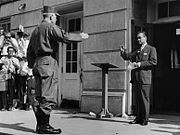Henry Graham (General)
| Henry V. Graham | |
|---|---|

General Graham salutes Governor Wallace at the University of Alabama
|
|
| Born | May 7, 1916 |
| Died | March 21, 1999 |
| Employer | National Guard of the United States |
| Title | General |
Henry Vance Graham (May 7, 1916 – March 21, 1999) was a National Guard general who protected black activists during the Civil Rights Movement. He is most famous for asking Alabama Governor George Wallace to step aside and permit black students to register for classes at the University of Alabama in Tuscaloosa in 1963 during the "Stand in the Schoolhouse Door" incident.
In 1934, at the age of 18, Graham joined the National Guard and served in the United States Army in Europe during World War II. In 1945, he attained the rank of Lt. Colonel and served in the Korean War in 1952. For his military services he received Bronze Star Medals and a Legion of Merit. He also served as Adjutant General for the State of Alabama from 1959 to 1961. In 1961, Graham was awarded the title of Brigadier General.
General Graham had several prominent roles in the American civil rights movement. In 1961, General Graham led the Alabama National Guard to protect the Freedom Riders from mob violence. On the evening of May 21, 1961, Freedom Riders and their supporters met at Ralph Abernathy's First Baptist Church in Montgomery, Alabama to honor their struggle. Martin Luther King, Jr also flew in to offer support. As white mobs gathered outside the church and became increasingly agitated, the Kennedy Administration and Alabama Governor John Malcolm Patterson agreed to employ Alabama National Guard troops to surround the church for safety. At the request of King, General Graham entered the church to inform the crowd that they would have to wait until the next morning to leave the church. At dawn, Graham arranged for the members of the crowd to be escorted to their homes. Two days later, on May 24, Graham was responsible for escorting the Freedom Riders from the Montgomery bus terminal to the Alabama-Mississippi border using a convoy of three planes, two helicopters, and seventeen highway patrol cars.
...
Wikipedia
